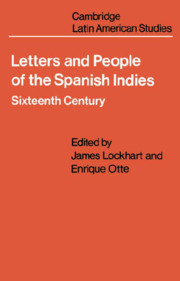Book contents
- Frontmatter
- Contents
- Preface
- Part I Conquest
- 1 Conquest in the personal view
- 2 A standard conqueror's report
- 3 The woman as conqueror
- 4 The merchant and the conquest of Peru
- 5 The merchant and the conquest of Mexico
- 6 The non-hero
- 7 The successful conqueror
- 8 The unsuccessful conqueror
- 9 The conqueror-governor
- 10 The conqueror in jail
- Part II The Variety of Life in the Indies
- Part III officials and Clerics
- Bibliography
- Index
9 - The conqueror-governor
from Part I - Conquest
Published online by Cambridge University Press: 06 August 2018
- Frontmatter
- Contents
- Preface
- Part I Conquest
- 1 Conquest in the personal view
- 2 A standard conqueror's report
- 3 The woman as conqueror
- 4 The merchant and the conquest of Peru
- 5 The merchant and the conquest of Mexico
- 6 The non-hero
- 7 The successful conqueror
- 8 The unsuccessful conqueror
- 9 The conqueror-governor
- 10 The conqueror in jail
- Part II The Variety of Life in the Indies
- Part III officials and Clerics
- Bibliography
- Index
Summary
Don Francisco Pizarro, conqueror and governor of Peru, marques and adelantado, in Lima, to Sebastian Rodriguez, his solicitor at the royal court, 1541
… I will be left the governor of sandflats …
The reward of the members of a successful expedition was an encomienda for each; the reward of the leader was the governorship of the area. If the new land was already somewhat known and the venture well planned and financed, the leader might have capitulated with the crown for the governorship in advance of the expedition. If the leader had only an ad hoc captaincy and license from the governor of the region where the expedition originated, he would proceed to apply for a royal appointment after the fact. Usually he would get what he asked for; he was in a very strong position locally, and the practice was firmly established in the customs of the Indies, so that the crown officials had little choice in the matter. They had little reason to disapprove in any case. One should not imagine a Machiavellian crown, plotting the immediate replacement of the conquerorgovernors in favor of pliable bureaucrats and viceroys. Many of the first governors received lifetime appointments, which were honored. But the pressures were such that those lives were often short. The crown was well served to let the conquerors’ momentum follow through to the establishment of a preliminary eq uilibrium, and wait for the natural course of further immigration, internal rivalries and Indian fighting to accomplish the replacement of the founder-governors quickly enough.
The whole sequence is well illustrated by the case of Francisco Pizarro and Peru. In Letter 2 we saw the origins of the venture under Governor Pedrarias de Avila of Tierra Firme; in Letter 4, indirectly, Pizarro's continued direction of the exploratory phase, and in Letter 1 the high point of the conquest, with Pizarro already styled governor on the basis of a capitulation obtained in Spain before the final expedition of 1532. He received high titles and honors. (Not the least of them was the don. Note that not another correspondent in this section, including Pedrarias, bore that title; today we can speak of Pizarro with propriety minus the ‘don’ only because, like Hernando Cortes, he had been without it for most of his lifetime.)
- Type
- Chapter
- Information
- Letters and People of the Spanish IndiesSixteenth Century, pp. 52 - 56Publisher: Cambridge University PressPrint publication year: 1976

